Python Help - Second ILI9341 Display White After Pi Update
-
Last night I decided to update RetroPie on my Super Famicom Pi 3. After that I applied the Raphnet fix as is required for the "Northwest" problem, and I rebooted. Now my secondary TFT is powering on, but is only displaying white. This morning I decided to SSH in and run the command manually to see if/what errors are showing up.
$ sudo python imageparam2.py neogeo.jpg Traceback (most recent call last): File "imageparam2.py", line 45, in <module> disp = TFT.ILI9341(DC, rst=RST, spi=SPI.SpiDev(SPI_PORT, SPI_DEVICE, max_speed_hz=64000000)) File "build/bdist.linux-armv7l/egg/Adafruit_ILI9341/ILI9341.py", line 132, in __init__ File "build/bdist.linux-armv7l/egg/Adafruit_GPIO/GPIO.py", line 420, in get_platform_gpio ImportError: No module named Adafruit_BBIO.GPIOFrom what I can see from the Adafruit website where I got the library, the BBIO stuff is a reference to BeagleBone Black, which I'm not using. My code is admittedly just a tweak of their stuff, but I didn't change it, and I'm trying to look through things to figure out why it's looking for this BeagleBone module. Can anyone lend some insight? I'm still messing with it, but it's frustrating.
Here's imageparam2.py over at Pastebin, warts and all. I'm still learning.
I haven't modified any of the Adafruit library files and I've tried reinstalling them, but that doesn't seem to do anything. I also don't see anything in the
build/bdist.linux-armv7l/folder that's referenced in the error at all. I must not understand how that works. -
I tried manually removing the Python modules (I'm learning more about Python by this not working) but even after doing that and reinstalling the Adafruit library, I'm getting the same error. I'm not sure why it's looking for that Adafruit_BBIO.GPIO module.
Just for the heck of it, I installed the module.
sudo pip install Adafruit_BBIONow when I run it I get something different. I still think something is funky that the Pi thinks it's a BeagleBone.
$ sudo python imageparam2.py neogeo.jpg Traceback (most recent call last): File "imageparam2.py", line 45, in <module> disp = TFT.ILI9341(DC, rst=RST, spi=SPI.SpiDev(SPI_PORT, SPI_DEVICE, max_speed_hz=64000000)) File "build/bdist.linux-armv7l/egg/Adafruit_ILI9341/ILI9341.py", line 134, in __init__ File "build/bdist.linux-armv7l/egg/Adafruit_GPIO/GPIO.py", line 278, in setup TypeError: argument 1 must be string, not intSome googling about the
TypeError: argument 1 must be string, not intleads to a StackOverflow post that mentions BeagleBone pins are strings, not integers.Why does my Pi think it's a BeagleBone?!
I removed Adafruit_BBIO
sudo pip uninstall Adafruit_BBIOand I'm back where I started.$ sudo python imageparam2.py neogeo.jpg Traceback (most recent call last): File "imageparam2.py", line 45, in <module> disp = TFT.ILI9341(DC, rst=RST, spi=SPI.SpiDev(SPI_PORT, SPI_DEVICE, max_speed_hz=64000000)) File "build/bdist.linux-armv7l/egg/Adafruit_ILI9341/ILI9341.py", line 132, in __init__ File "build/bdist.linux-armv7l/egg/Adafruit_GPIO/GPIO.py", line 420, in get_platform_gpio ImportError: No module named Adafruit_BBIO.GPIOI really wish I knew what yesterday's update changed behind the scenes. In hindsight when it asked "Do you want to update the OS/Kernel?" I should have said "No" :-/
-
As I've often said "the best way to find out how something works is when it doesn't"
I learned that the python modules end up being installed in
/usr/local/lib/python2.7/dist-packagesFrom there I saw some
.eggfilesAfter determining that a
.eggis just a renamed.zipfile, I extracted the two Adafruit files to take a look at what was going on, and why it though my Pi was a BeagleBoneIn the
Adafruit_GPIO-1.0.2-py2.7.eggfile there is a folder namedAdafruit_GPIOand in there is a file namedGPIO.pyas was referenced by the error message.GPIO.pyon line408runs theget_platform_gpiofunction. Line420is where it looks for a Beaglebone if it can't find a Raspberry Pi.def get_platform_gpio(**keywords): """Attempt to return a GPIO instance for the platform which the code is being executed on. Currently supports only the Raspberry Pi using the RPi.GPIO library and Beaglebone Black using the Adafruit_BBIO library. Will throw an exception if a GPIO instance can't be created for the current platform. The returned GPIO object is an instance of BaseGPIO. """ plat = Platform.platform_detect() if plat == Platform.RASPBERRY_PI: import RPi.GPIO return RPiGPIOAdapter(RPi.GPIO, **keywords) elif plat == Platform.BEAGLEBONE_BLACK: import Adafruit_BBIO.GPIO return AdafruitBBIOAdapter(Adafruit_BBIO.GPIO, **keywords) elif plat == Platform.MINNOWBOARD: import mraa return AdafruitMinnowAdapter(mraa, **keywords) elif plat == Platform.UNKNOWN: raise RuntimeError('Could not determine platform.')Platform.pycontains theplatform_detect()function.That attempts to get the version of the pi with the
pi_version()function.The
pi_version()function is the problem.def pi_version(): """Detect the version of the Raspberry Pi. Returns either 1, 2 or None depending on if it's a Raspberry Pi 1 (model A, B, A+, B+), Raspberry Pi 2 (model B+), or not a Raspberry Pi. """ # Check /proc/cpuinfo for the Hardware field value. # 2708 is pi 1 # 2709 is pi 2 # Anything else is not a pi. with open('/proc/cpuinfo', 'r') as infile: cpuinfo = infile.read() # Match a line like 'Hardware : BCM2709' match = re.search('^Hardware\s+:\s+(\w+)$', cpuinfo, flags=re.MULTILINE | re.IGNORECASE) if not match: # Couldn't find the hardware, assume it isn't a pi. return None if match.group(1) == 'BCM2708': # Pi 1 return 1 elif match.group(1) == 'BCM2709': # Pi 2 return 2 else: # Something else, not a pi. return NoneIt's returning
Noneso I decided to see why.I ran
cat /proc/cpuinfoand I found my culprit:Hardware : BCM2835I'm not sure when this changed. I powered up another Pi 3 with an older version of Jessie on it and it reports
Hardware : BCM2709I also checked my Genesis Pi 3 which is as up to date as the Super Famicom Pi 3 and it's also reporting
BCM2709. I'm thinking that when I applied the Raphnet patch to the kernel, that new chip identification came in to play.To try to fix the issue I tried updating the function, rezipping the
.eggand replacing the original Adafruit one.With that modified module in place, the screen is once again working. Kind of. I'm getting garbled output, but at least it's doing something.
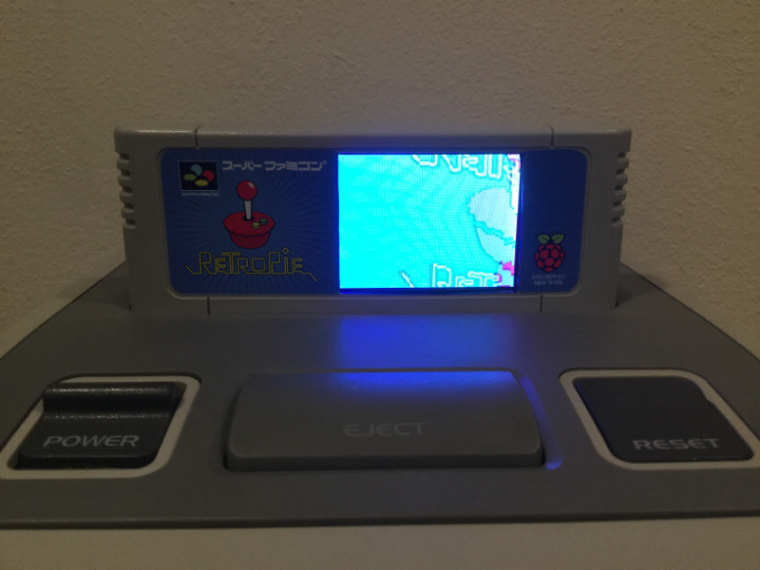
-
I updated RetroPie to 4.1.17 just now, and thinking that maybe there may be a kernel update reapplied (there wasn't) I rebooted. The display was perfect! I checked the CPU and it's still reporting as a
BCM2835. Then I went into a game, and the screen was back to garbled. At this point I'm thnking I may have a loose connection after removing and reinserting the cartridge.Yes, I did try taking it out, blowing on it, and sticking it back in ;)
(I know that doesn't really work)
-
I confirmed it's not a loose connection. I took the case apart, checked the wires, and the display was still giving garbled output. I then decided to try dusting off the
pygamestuff I had been messing with months ago, and sure enough, the display works perfectly. (there's a cursor in the top left, which I don't remember before, but it's clearly not bad output.)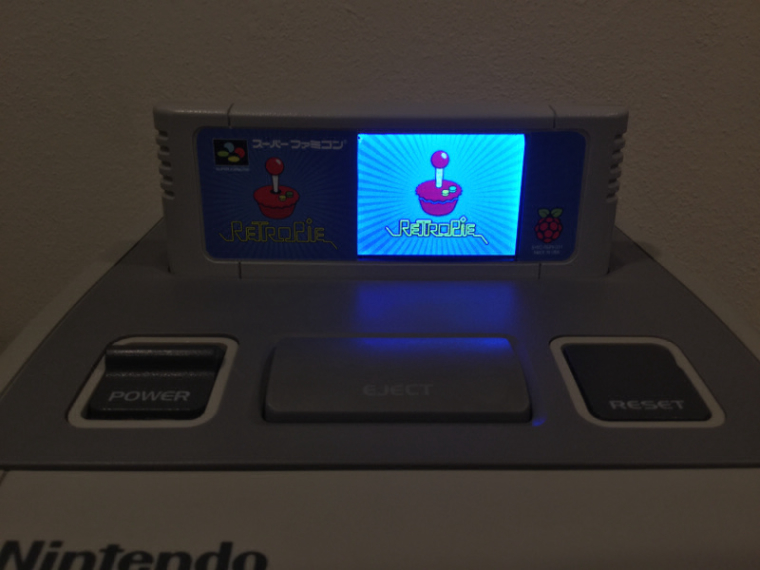
Now that I know it's a software issue with the Adafruit stuff, I need to figure out what the heck is going on with the garbledocity of its output.
-
I managed to turn off the mouse pointer in
pygamebutpygametends to chew up CPU cycles to the point that it's noticably slower when I SSH in. I could press on with making pygame respond to runcommand, but I'd really rather get this Adafruit stuff working again.I'm not sure how to troubleshoot the scrambled display output. At least when I had that initial error message I had something to go on, but I'm not sure about where to create logs/traces while the python code is running to see what's going on.
Frustrating.
-
@obsidianspider Well, nobody can accuse you of not providing enough detail! ;-)
I have not been following your project and I am not familiar with the issue, but I had to post a quick reply and ask, is that a tiny screen on a cartridge, or a huge replica of a game console? Either way, it is looking pretty cool! I hope you get everything working the way you want.
-
@caver01 said in Python Help - Second ILI9341 Display White After Pi Update:
Well, nobody can accuse you of not providing enough detail! ;-)
I'm really kind of stuck here, and it's frustrating because it used to work just fine. For months. I'm documenting what I tried not only for detail, but also to try to help anyone else who may run into this problem.
I'm getting quite upset at not being able to figure this out. I may try to put a fresh image on a different SD card, update it, then install the Adafruit stuff and see how that goes. I dunno.
-
@obsidianspider I have since reviewed your project thread and I gotta say, my hat's off to you! Very nice build. I hope you figure this out (I am sure you will). It has inspired me to finally take a closer look at my mausberry circuit and switch it over to a python script. I am sure I am just wasting CPU cycles. Your setup is a bit beyond me. I have some learning to do.
-
I have said before that one of the nice things about the Raspberry Pi is that it's a "low consequence" computer, meaning that worst case, you can either just pop in a new disk or if the whole hing explodes, you're only out $35 or so.
After spending HOURS yesterday on figuring out what was going on with the screen not working and ultimately ending up with garbled output, I decided to take another Micro SD card, put a fresh image of RetroPie on it, update it fully, including Raspbian, and then reinstall the Adafruit library, and try again.
Lo and behold, it works.
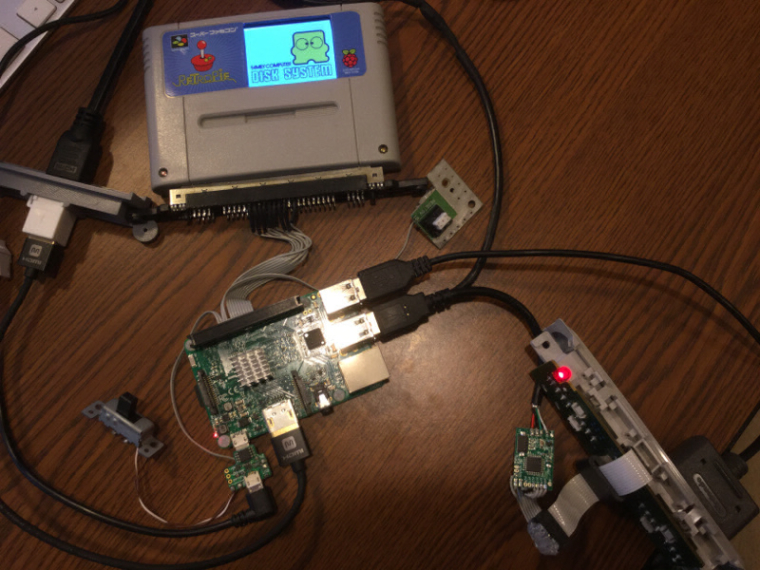
Since the problem before seemed to stem from the bad identification of the SOC I ran
cat /proc/cpuinfoand I'm seeing theHardware : BCM2709that my other Pi 3s are showing. I only put one game on to see how things are working, but in the RetroPie menu I'm getting the "Northwest" problem, so I'm going to apply the patch and see what happens. That takes a few hours to run, so we'll see.
-
It looks like I'm not the first one to notice the BCM2835 issue. Even our RetroPie team has noticed it.
-
After running the Raphnet fix, the CPU is once again reporting as BCM2835, so that's the issue, apparently the kernel coders have decided to correctly report the chip, which ultimately is a good thing, but it breaks this Adafruit script. Now to try to fix it again on the new image.
-
Sure enough, fixing the GPIO module to tell it that it's a
BCM2835resulted in the same garbled image. Which tells me that something else is looking for thatBCM2709and is freaking out because it can't find it.Oh well, at least I'm getting somewhere.
Time to pop the original SD card back in.
-
I can't seem to tell if the issue is with the new kernel, or another piece in the Adafruit libraries that is somehow misidentifying the SOC.
I can see this being a bigger problem going forward too, because in doing a search for
BCM2709on my machine I see that Adafruit'sretrogamealso usesBCM2709to determine GPIO layout.I wonder if this is something I should bring up on Github? I'm not even sure how to do that exactly.
-
I sent a message via the feedback link on Adafruit's site, but not sure if that will do anything.
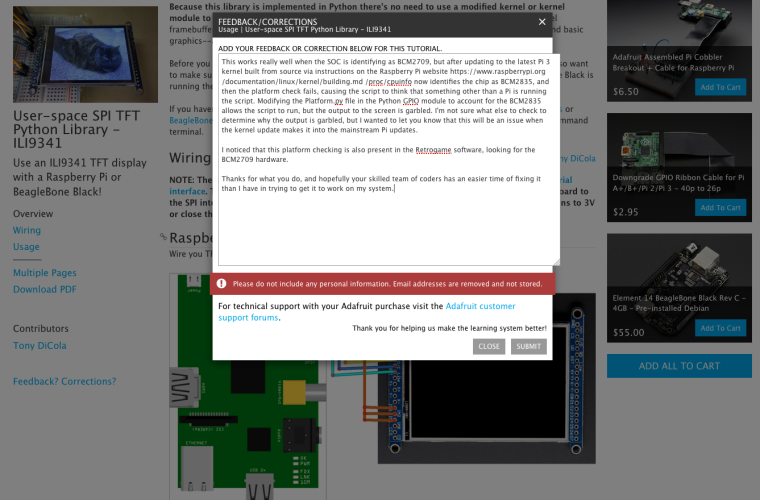
-
I also put a message up over at the Adafruit forums since Github says to try there first .
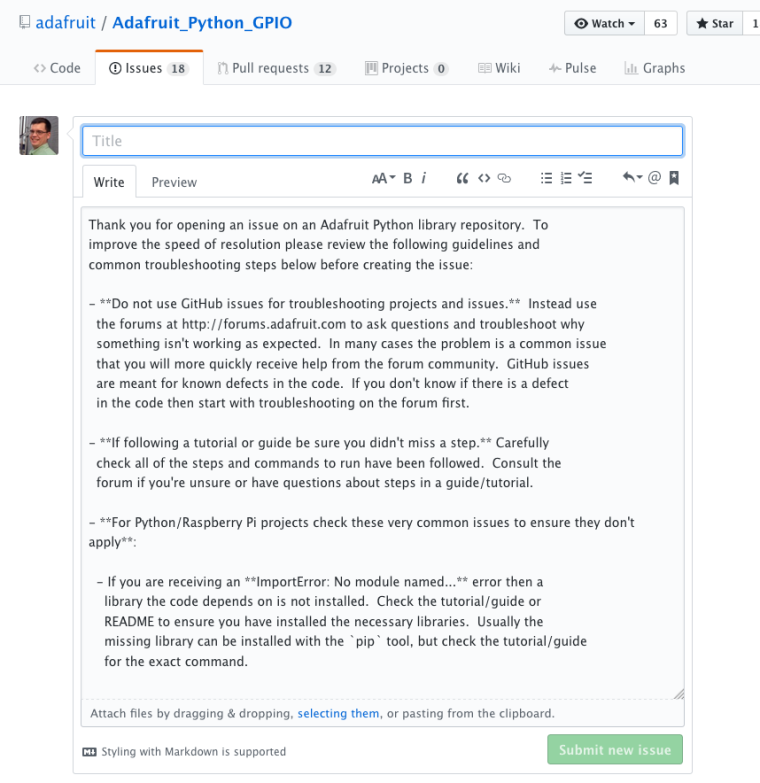
-
@obsidianspider just throwing this out there but might be mutually beneficial if adafruit were willing to work on a module with us for inclusion with the setup script (more people would probably buy their hardware if there was an "easier" setup) I've been meaning to make a handheld (one day!)
-
@herb_fargus This particular library wouldn't help with a handheld as it's just for static images, but they do have others that are used in their handheld kids/projects for enabling TFTs and also their Retrogame library (which I plan to use with a Pi 3 if I can get the 3 trimmed down enough to fit).
If I didn't need the "Northwest Fix" I'd reimage my spare SD card again, and be done with it, but I think that's shortsighted, because eventually that BCM2835 identifier will find its way into "regular" updates and then all kinds of stuff is going to break, as BuZz pointed out in that Github thread.
I'm hopeful someone will figure out what's going on with that garbled output, but I don't know if the updated kernel is causing issues, if the libraries Adafruit is using is doing something weird, or if my code modification to cause the platform to be detected as a Pi is to blame.
I don't know enough about Python, programming, hardware, or Linux to fully grasp this, but I'm sure as heck learning a lot as I've been digging into the issue.
-
More confirmation that there's likely something up with SOC identification. When I was updating my Genesis Pi I noticed that the kernel was updated to 20170303, so I figured I'd update my Super Famicom Pi just to see what happens. Sure enough, after applying the new kernel, the SOC is once again identifying as
BCM2709and the screen is working correctly. That darn "Northwest" problem is back again though, so I'm going to try re-running the fix and see how that goes. If I knew where in the kernel source the SOC hardware identification was located I'd just change it, but I don't know where to look.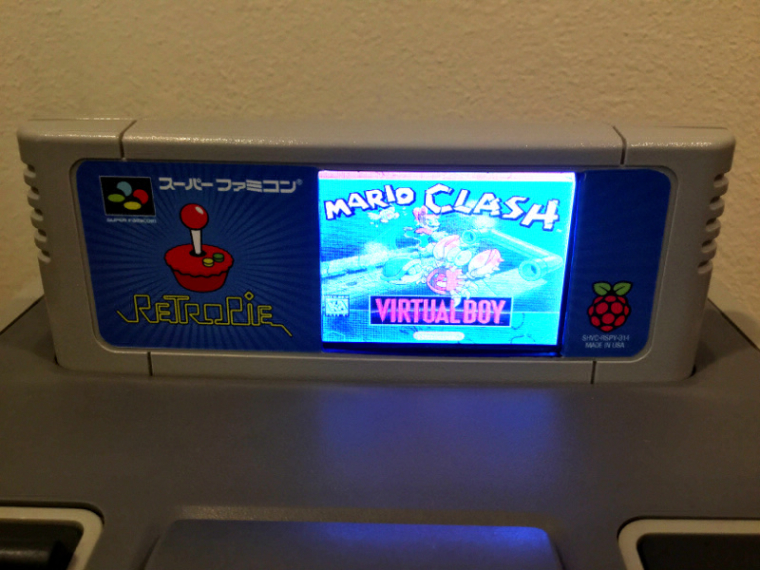
-
It's working!
I reapplied the Raphnet kernel patch. The CPU is once again showing as
BCM2835, but my screen's output is fixed! It looks like the20170303version of the kernel fixed the issue.I'm really going to think twice about updating the software on my now working Super Famicom Pi.
Contributions to the project are always appreciated, so if you would like to support us with a donation you can do so here.
Hosting provided by Mythic-Beasts. See the Hosting Information page for more information.